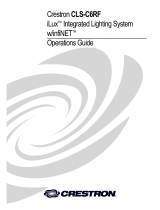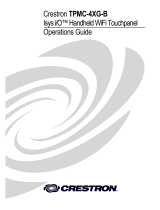Page is loading ...

Crestron TPS-RFGWX 2-Way RF Transceiver
2-Way RF Transceiver:
TPS-RFGWX
Purpose
This addendum provides additional detail to the description of Wi-Fi Technology
that begins on page 2 of the TPS-RFGWX Operations Guide (Doc. 5847A).
Additional Description of Wi-Fi Technology
The paragraphs below follow the last paragraph of the “Wi-Fi Technology” topic:
When configuring a Cresnet system that includes Crestron RF wireless devices that
broadcast in the 2.4 GHz spectrum, in a facility that also contains one or more
802.11b-compliant RF devices, it is important to bear in mind how each
implementation uses the frequency bandwidth, and how they may interact.
The 802.11b spectrum ranges from 2400 MHz to 2497 MHz, and is divided into
channels spaced at 5 MHz intervals. Each channel, though, is 22 MHz wide (±11
MHz around the center frequency), which results in some overlap between channels.
For instance: Channel 1 is centered at 2412 MHz, but extends from 2401 MHz to
2423 MHz, overlapping Channels 2 through 5; Channel 6 is centered at 2437 MHz,
but extends from 2426 MHz to 2448 MHz, overlapping Channels 2 through 10. In an
installation with two or more 802.11b RF devices, the use of Channels 1, 6, and 11 is
safest since that choice produces no overlap.
As described earlier, Crestron RF devices make use of bands that define frequency
ranges within the same spectrum. For example, Band 5 uses frequencies that
correspond to 802.11b Channels 1 through 5, but do not overlap Channels 6 and
higher. Band 9 uses frequencies that correspond to Channels 5 through 13, but do not
overlap Channels 4 and below. The goal is to select bands for the Crestron RF
devices and channels for adjacent 802.11b devices to minimize or eliminate overlap
between them. For example, if the Crestron devices are set to Band 5, and nearby
802.11b devices are set to Channels 6 and/or 11, there is no overlap.
Crestron Electronics, Inc. Addendum #1 for DOC. 5847A
15 Volvo Drive Rockleigh, NJ 07647 03.04
Tel: 888.CRESTRON
Fax: 201.767.7576 Specifications subject to
www.crestron.com change without notice.
/





